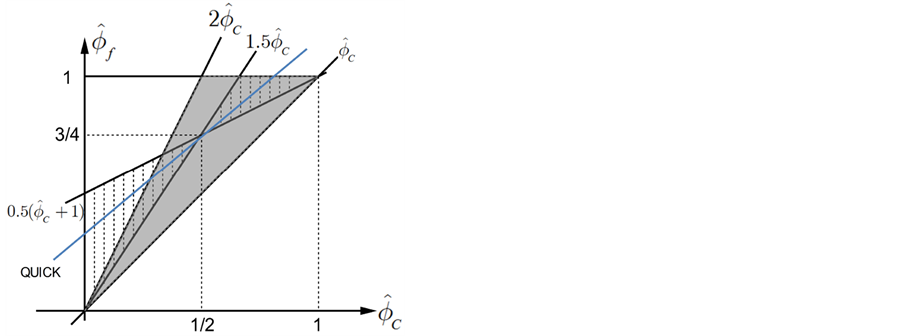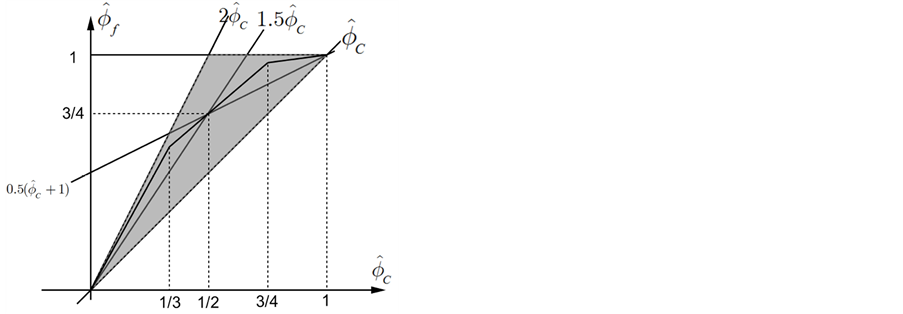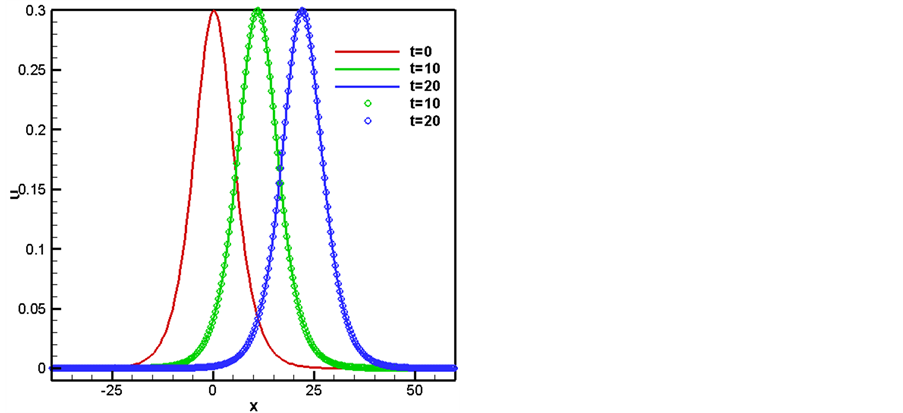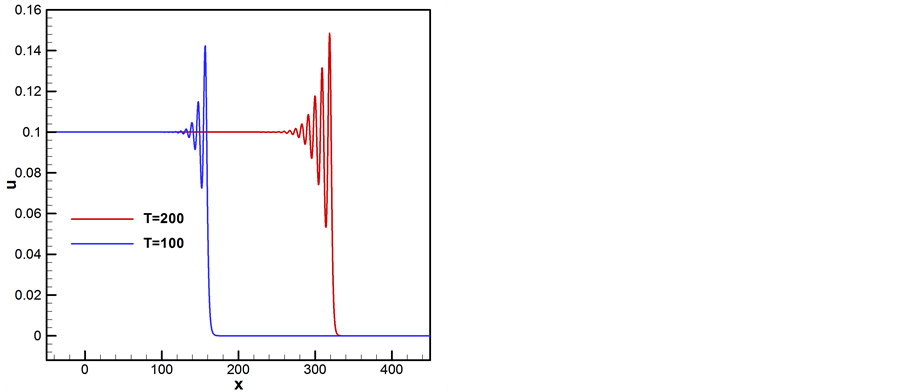International Journal of Fluid Dynamics
Vol.2 No.01(2014), Article ID:13210,10 pages
DOI:10.12677/IJFD.2014.21001
A High Resolution NV/TVD Finite Volume Scheme for the Regularized Long Wave Equation
School of Mathematical Sciences, Inner Mongolia University, Hohhot
Email: mathgao@mail.ustc.edu.cn, suiguoqin123@163.com, smslh@imu.edu.cn
Copyright © 2014 by authors and Hans Publishers Inc.
This work is licensed under the Creative Commons Attribution International License (CC BY).
http://creativecommons.org/licenses/by/4.0/



Received: Feb. 6th, 2014; revised: Feb. 12th, 2014; accepted: Feb. 15th, 2014
ABSTRACT
An oscillation-free high order scheme is presented for regularized long wave equations by using the normalized-variable formulation in the finite volume framework. It adopts the QUICK finite volume scheme as the basic scheme to obtain high order accuracy in smooth solution domain. In order to suppress unphysical oscillations of numerical solutions by high order linear schemes, the CBC (convection boundness criterion) condition is combined with the TVD (total variation diminishing) constraint to design a bounded QUICK scheme. Numerical results demonstrate that the present scheme possesses good robustness and high resolution.
Keywords:Regularized Long Wave Equation; TVD; CBC; Finite Volume

求解正则长波方程的一种基于NV/TVD的
高分辨率有限体积格式
高 巍,睢国钦,李 宏
内蒙古大学数学科学学院,呼和浩特
Email: mathgao@mail.ustc.edu.cn, suiguoqin123@163.com, smslh@imu.edu.cn
收稿日期:2014年2月6日;修回日期:2014年2月12日;录用日期:2014年2月15日

摘 要
本文构造了一种求解正则长波方程的高分辨率高阶有限体积格式,它以QUICK有限体积格式作为基础格式,以期在光滑解区域获得数值高精度。另外,它结合TVD和CBC两种对流有界准则来抑制数值解的非物理振荡。几个典型的算例表明,本文提出的数值格式保持了有限体积方法良好的守恒性,同时又具有高精度和良好的计算稳定性。
关键词
正则长波方程;TVD;CBC;有限体积方法

1. 引言
正则长波方程(Regularized Long Wave Equation, RLW)可表达为

其中 ,
, 是正常量。它是描述大量重要的物理现象(如浅水波,离子波等)的主要的模型方程,尤其在非线性色散波研究方面有着重要的作用。正则长波方程是非线性方程,解析解通常难于计算。因此数值计算成为一种重要的研究方法。在数值求解过程中,非线性对流项的数值离散是最关键的环节。对流项的处理要求在解的光滑区域时具有较高精度,在激波或大梯度附近时稳定且有界。传统的高阶数值格式,如中心差分格式CD
(Central Difference),二阶迎风格式SOU (Second-order Upwind)[1] ,QUICK (Quadratic Upstream
Interpolation for Convective Kinematics)格式[2] 及三次迎风插值格式CUI (Cubic Upwind Interpolation)[3]
是最常见的用于对流项离散的高阶格式,但它们都不满足有界性,容易产生非物理振荡。为此,需要将对流有界性与高阶精度结合,构造非线性高分辨率格式[4] [5] 。
是正常量。它是描述大量重要的物理现象(如浅水波,离子波等)的主要的模型方程,尤其在非线性色散波研究方面有着重要的作用。正则长波方程是非线性方程,解析解通常难于计算。因此数值计算成为一种重要的研究方法。在数值求解过程中,非线性对流项的数值离散是最关键的环节。对流项的处理要求在解的光滑区域时具有较高精度,在激波或大梯度附近时稳定且有界。传统的高阶数值格式,如中心差分格式CD
(Central Difference),二阶迎风格式SOU (Second-order Upwind)[1] ,QUICK (Quadratic Upstream
Interpolation for Convective Kinematics)格式[2] 及三次迎风插值格式CUI (Cubic Upwind Interpolation)[3]
是最常见的用于对流项离散的高阶格式,但它们都不满足有界性,容易产生非物理振荡。为此,需要将对流有界性与高阶精度结合,构造非线性高分辨率格式[4] [5] 。
TVD[4] 条件和CBC (BAIR)[6] [7] 条件是两个主要的对流有界性条件。已知的很多限制器函数都是基于TVD性质的,如Sweby提出的MINMOD[5] ,Roe的SUPERBEE[8] 及Van Leer的MUSCL[9] 等。另外,Gaskell和Lau提出CBC (Convection Boundedness Criterion)[10] 条件来构造对流有界的数值格式。为了弥补原始CBC条件对数值格式精度不做限制的缺陷,Wei et al.[6] 和Hou et al.[7] 提出BAIR条件(Boundedness, Accuracy and Interpolative Reasonableness),它使得对流项的数值格式同时具有有界性和高精度。然而,与TVD格式相比,CBC类的数值格式在计算激波管流动等问题时,仍然会产生非物理振荡[11] 。有限差分[12] -[14] 和有限元[15] -[18] 是常见的用于正则长波方程数值方法,但是基于有限体积方法的数值格式并不多见。一般来说,有限差分方法是以基于点值泰勒展开来构造数值格式的,有限元方法是以极小位能原理或极小残量方法为基础,以分段或分片多项式的形式来构造数值格式的。它们都不是天然的基于守恒原理的数值方法,为此常常要特别去构造守恒的有限差分或有限元格式。与它们相比,有限体积方法以守恒原理为基础,在计算与守恒律相关的问题时,自然就可以得到守恒格式,而这对于得到符合物理意义的数值解,是十分重要的。
本文以QUICK有限体积格式为基础,构造了一个满足TVD和CBC-BAIR条件的高阶无振荡有限体积格式,用于数值求解正则长波方程。本文的安排具体如下:第2节建立对流项的高分辨率有限体积格式和扩散项的数值离散;第3节给出典型数值算例;第4节给出结论。
2. 数值格式的建立
正则长波方程的守恒形式为
 (1)
(1)
将计算区间 进行
进行 等分,记为
等分,记为
 每个控制单元
每个控制单元 的长度为
的长度为 。(1)式在
。(1)式在 上积分,可得
上积分,可得

进而可得

其中 。若记
。若记 是第
是第 个单元的单元平均值,则有
个单元的单元平均值,则有

2.1. 对流项离散
2.1.1. 两种对流有界准则
如图1所示,U、C、D是相邻的3个网格的节点,分别表示上游、中心和下游的三个节点, 表示控制单元的界面。界面值
表示控制单元的界面。界面值 可表达为
可表达为

这里参数 分别对应常见的SOU,CD和QUICK格式。由Leonard的变量正则化方法[19],定义正则化变量(Normalized
Variable, NV)为
分别对应常见的SOU,CD和QUICK格式。由Leonard的变量正则化方法[19],定义正则化变量(Normalized
Variable, NV)为


Figure 1. Three neighboring mesh points and the mesh face
图1. 三个相邻的节点及单元边界
这里 可以取值为
可以取值为 ,进而
,进而 ,于是
,于是 可表达为
可表达为

这意味着,在引入正则化变量表达形式后, 只是
只是 的函数。这一简化的数学关系为构造新的格式带来了方便。为了改进Gaskell和Lau提出的CBC条件对于数值格式精度无限制的缺点,Wei和Hou提出的了BAIR[6]
[7] 约束条件,其数学形式为
的函数。这一简化的数学关系为构造新的格式带来了方便。为了改进Gaskell和Lau提出的CBC条件对于数值格式精度无限制的缺点,Wei和Hou提出的了BAIR[6]
[7] 约束条件,其数学形式为

另外,Sweby将TVD约束条件用限制器函数表示为[5]

其中 是一个限制器函数,其中
是一个限制器函数,其中 。TVD条件也可以表示为
。TVD条件也可以表示为

综上,将BAIR区域与TVD区域绘制于图2中。
2.1.2. 对流项离散格式
有限体积QUICK格式为

其正则化变量表达式为

由图2中绘制出QUICK格式对应的NV线可以看到,已超出TVD和BAIR的交集区域,这表明QUICK格式不是对流有界的。为此对QUICK格式加以改进,使之满足对流有界性。根据TVD和BAIR的要求,
当 时,应满足
时,应满足 ,
, ;当
;当 时,应满足
时,应满足
 。根据以上分析,改进格式可表示为
。根据以上分析,改进格式可表示为

为格式计算方便,可取参数 ,则一个无振荡QUICK有限体积格式为
,则一个无振荡QUICK有限体积格式为

Figure 2. The regions of the TVD (shaded) and BAIR (hatched)
图2. BAIR区域(虚线部分)和TVD区域(阴影部分)

该格式的NV线在BAIR区域和TVD区域内的图像见图3。
2.2. 扩散项离散
以 的数值离散为例。利用
的数值离散为例。利用 四个单元平均值,构造一个3次重构多项式
四个单元平均值,构造一个3次重构多项式 。利用局部坐标表达式
。利用局部坐标表达式 ,可得
,可得

解得

于是 的数值格式可以表示为
的数值格式可以表示为


Figure 3. The NV line of the oscillation-free QUICK scheme in the BAIR and TVD region
图3. 非振荡QUICK格式在BAIR和TVD区域中的图像
2.3. 时间离散
完成上述关于空间变量的半离散后,形成关于时间的常微分方程组 。为有效抑制非物理振荡,此常微分方程组采用常用的三阶TVD
Runge-Kutta格式[20]
。为有效抑制非物理振荡,此常微分方程组采用常用的三阶TVD
Runge-Kutta格式[20]

3. 数值实验
正则长波方程有三种守恒律

其中 、
、 、
、 分别对应质量,动量和能量,根据
分别对应质量,动量和能量,根据 、
、 、
、 的值来检验数值方法的的守恒性。在
的值来检验数值方法的的守恒性。在 时刻,数值方法的误差用以下三个误差范数计算:
时刻,数值方法的误差用以下三个误差范数计算:

精度阶用以下公式计算

其中 是误差范数,
是误差范数, 是网格数,
是网格数, 是
是 的
的 倍。
倍。
3.1. 孤立波
RLW方程的孤波解析解为

其中 ,
, 是孤波的振幅,
是孤波的振幅, 是波速。相应参数取值为
是波速。相应参数取值为 ,
, ,
, ,
, ,
, 。CFL
= 0.4。利用周期边界条件,根据以上分析,可以计算出孤波的数值解。数值模拟过程中的误差及相应的误差范数见表1。在这个数值实验中,三个守恒量I1、I2、I3的准确值的计算公式是:
。CFL
= 0.4。利用周期边界条件,根据以上分析,可以计算出孤波的数值解。数值模拟过程中的误差及相应的误差范数见表1。在这个数值实验中,三个守恒量I1、I2、I3的准确值的计算公式是:

表2列出网格数为800时,不同时刻的三个守恒律的准确值与数值解值,表明了本文格式良好的守恒性。表3是本文格式与其他几种格式在误差与守恒量方面的比较。从图4可以看到一个孤波在不同时刻的数值解与准确解的对比图像。
3.2. 两个孤波相互作用
为模拟两个孤波的相互作用,RLW方程的初始解取为

其中 ,振幅是
,振幅是 的单波的波峰位于直线
的单波的波峰位于直线 上,而振幅是
上,而振幅是 的单波的波峰位于直线
的单波的波峰位于直线 上。将参数赋值为:
上。将参数赋值为: ,
, ,
, ,
, ,
, ,
, ,
, ,
, ,
, 。图5描绘了两个孤波相互作用的过程。从图5可以看出,振幅更大的孤波传播的速度更快。在两个孤波相互作用后,它们保持初始的振幅各自继续向前传播。在这个数值实验中,三个守恒量
。图5描绘了两个孤波相互作用的过程。从图5可以看出,振幅更大的孤波传播的速度更快。在两个孤波相互作用后,它们保持初始的振幅各自继续向前传播。在这个数值实验中,三个守恒量 ,
, ,
, 的准确值的计算公式是:
的准确值的计算公式是:

它们的准确值及不同时刻的数值解值见表4,它表明该格式是一个守恒性很好的数值格式。
3.3. 振荡波(wave undulation)
给定如下的初始条件 和边界条件
和边界条件 ,正则长波方程可以发展出一种振荡波(wave
undulation)。这里各种参数取为[17] [18]
,正则长波方程可以发展出一种振荡波(wave
undulation)。这里各种参数取为[17] [18]

参数 决定波的振荡频率。此种振荡波的特点是随着时间发展,振荡性越强;另外,
决定波的振荡频率。此种振荡波的特点是随着时间发展,振荡性越强;另外, 越小,振荡性越强。从图6和图7给出在不同
越小,振荡性越强。从图6和图7给出在不同 的取值下,两个选定时刻
的取值下,两个选定时刻 和
和 的波形。可以看到,本文给出的数值模拟结果与之前已有的计算和分析吻合的很好。
的波形。可以看到,本文给出的数值模拟结果与之前已有的计算和分析吻合的很好。
4. 总结
本文构造了一种正则长波方程的对流项无振荡有限体积QUICK格式。利用重构多项式构造扩散项的中心离散格式。在正则长波方程的数值离散过程中,最关键的环节是对流项的数值离散。对流项的处理要求在光滑解区域时具有较高精度,解的大梯度附近稳定且有界。BAIR条件和TVD条件是保证数值格式具有对流有界性的两个重要的约束条件。因此,对QUICK格式不满足两个条件的部分加以改进,从而得到对流项的无振荡的高阶数值格式。正则长波方程的三个典型数值算例表明该格式具有良好的守恒性
表1. t = 10时数值解的误差范数及相应的精度阶
表2. N = 800时不同时刻的三个守恒律的准确值与数值解值
表3. 在t = 20时刻N = 800时本文格式与其他格式的比较

Figure 4. A profile of numerical solution and exact solutio
图4. 单波传播的数值解(实线)和准确解(圆形线)图像

Figure 5. Interaction of two solitary waves
图5. 两个孤波相互作用的过程的图像
表4. 两个孤波相互作用过程中三个守恒律的数值解值

Figure 6. Wave undulations at two time instants for d = 5
图6. 不同时刻的振荡波:d = 5

Figure 7. Wave undulations at two time instants for d = 2
图7. 不同时刻的振荡波:d = 2
和计算高分辨率。
致 谢
作者感谢审稿专家给予本文宝贵的修改意见和建议以及期刊编辑对于本文的付出。
参考文献 (References)
- [1] Shyy, W. (1985) A study of finite difference approximations to steady-state, a convection-dominated flow problem. Journal of Computational Physics, 57, 415-438.
- [2] Leonard, B.P. (1979) A stable and accurate modeling procedure based on quadratic interpolation. Computer Methods in Applied Mechanics and Engineering, 19, 59-98.
- [3] Agarwal, R.K. (1981) A third-order-accurate upwind scheme for Navier-Stokes solutions at high Reynolds numbers. 19th AIAA Aerospace Sciences Meeting, St. Louis, 12-15 January 1981, 15 p.
- [4] Harten, A. (1983) High resolution schemes for hyperbolic conservation law. Journal of Computational Physics, 49, 4357-4393.
- [5] Sweby, P.K. (1984) High resolution schemes using flux limiters for hyperbolic conservation laws. SIAM Journal on Numerical Analysis, 21, 995-1011.
- [6] Wei, J., Bo Yu, B. and Tao, W.Q. (2003) A new high-order-accurate and bounded scheme for incompressible flow. Numerical Heat Transfer Part B, 43, 19-41.
- [7] Hou, P.L., Tao, W.Q. and Yu, M.Z. (2003) Refinemet of the convective boundedness criterion of Gaskell and Lau. Engineering with Computers, 20, 1023-1043.
- [8] Roe, P.L. (1986) Characteristic-based schemes for the Euler equations. Annual Review of Fluid Mechanics, 18, 337- 365.
- [9] Van Leer, B. (2005) Towards the ultimate conservative difference scheme. Journal of Computational Physics, 202, 196-215.
- [10] Gaskell, P.H. and Lau, A.K.C. (1988) Curvature-compensated convective transport: SMART, a new boundness-perserving transport algorithm. International Journal for Numerical Methods in Fluids, 8, 617-641.
- [11] Lin, H. and Chieng, C.C. (1991) A characteristic-based flux limiter of an essentially 3rd-order flux-splitting method for hyperbolic conservation laws. International Journal for Numerical Methods in Fluids, 13, 287-301.
- [12] Ramos, J.I. (2006) Explicit finite difference methods for the EW and RLW equations. Applied Mathematics and Computation, 179, 622-638.
- [13] Pan, X. and Zhang, L. (2012) On the convergence of a conservative numerical scheme for the usual Rosenau-RLW equation. Applied Mathematical Modelling, 36, 3371-3378.
- [14] Pan, X., Zheng, K. and Zhang, L. (2013) Finite difference disretization of the Rosenau-RLW equation. Applicable Analysis, 92, 2578-2589.
- [15] Raslan, K.R. (2005) A computational method for the regularized long wave (RLW) equation. Applied Mathematics and Computation, 167, 1101-1118.
- [16] Avilez-Valente, P. and Seabra-Santos, F.J. (2004) A Petrov-Galerkin finite element scheme for the regularized long wave equation. Computational Mechanics, 34, 256-270.
- [17] Bhardwaj, D. and Shankar, R. (2000) A computational method for regularized long wave equation. Computers & Mathematics with Applications, 40, 1397-1404.
- [18] Dag, I., Dogan, A. and Saka, B. (2003) B-spline collocation methods for numerical solutions of the RLW equation. International Journal of Computer Mathematics, 80, 7430-757.
- [19] Leonard, B.P. (1988) Simple high-accuracy resolution program for convective modeling of discontinuities. International Journal for Numerical Methods in Fluids, 8, 1291-1318.
- [20] Gottlieb, S. and Shu, C-W. (1998) Total variational diminishing Runge-Kutta schemes. Mathematics of Computation, 67, 73-85.
